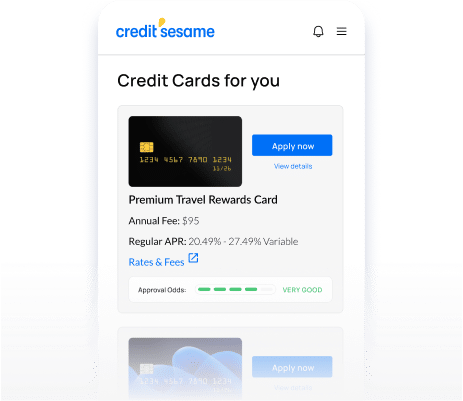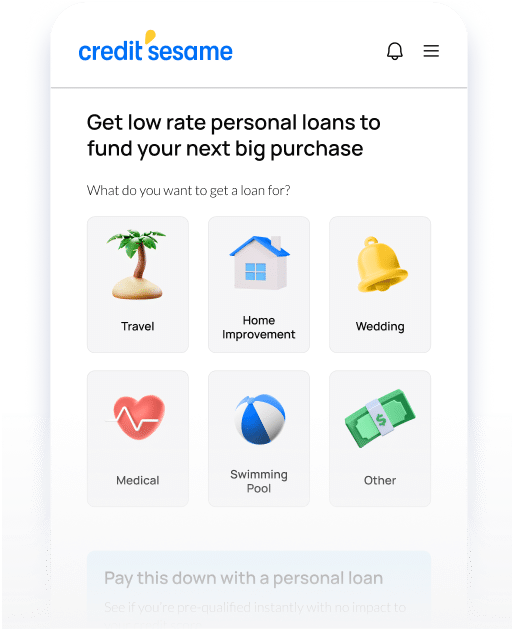What are federal student loans?
Federal student loans are the most popular type of education loan. They are relatively easy to get and have clear advantages over private student loans.
There are a variety of options when it comes to federal student loans. Knowing the details of these options and other key characteristics of federal student loans can help a borrower make the right decisions.

Find the right loan for you
Gain access to personalized loan recommendations based on your credit profile and approval odds. 100% free.
By clicking on the button above, you agree to the Credit Sesame Terms of Use and Privacy Policy.
- ON THIS PAGE
- What is a federal student loan?
- Types of federal student loans
- Key features of federal student loans
- Federal student loan repayment plans
- Federal student loan borrowing limits
- Alternatives to federal student loans
- Pros and cons of federal student loans
- Applying for a federal student loan
- In a nutshell
Share this
What is a federal student loan?
- Tuition
- Room and board
- Fees
- Books
- School supplies
- Transportation
- Computer for school
Federal student loans have a variety of advantages over student loans offered by private lenders.
Types of federal student loans
The names and terms of different federal student loan programs have changed over time. However, there are three major categories of federal student loans:
Subsidized loans
With a subsidized loan, the federal government covers the cost of interest while you are in school. This means that the interest costs are not added to the capital you owe before you have to start repaying the loan. Subsidized loans are only available for undergraduate programs and do not require a credit check. However, eligibility is based on financial need, and the amount you can borrow is limited.
Unsubsidized loans
With unsubsidized loans, the federal government does not cover the interest cost while you are still in school. You do not have to start making payments while you are still in school, but interest charges will be added to what you owe. Unsubsidized federal student loans are available for undergraduate and graduate programs. They do not require a credit check and are not based on financial need, but they are subject to limits on how much you can borrow.
PLUS loans
Key features of federal student loans
Whichever type of federal student loans you consider, there are some key features you should be aware of before you sign up:
Interest rate
Low interest rates are a primary attraction of federal student loans. They are generally lower than the interest rates on private student loans.
Federal student loan interest rates are fixed, meaning they do not change over the repayment term. However, interest rates on new federal student loans may change yearly. So, for example, when you take out a loan to finance your sophomore year of college, the rate may differ from the loan you got for your freshman year.
Interest rates for federal student loans are standardized, so there is no need to shop around to compare rates from different lenders. However, federal student loan rates vary according to the type of program. Generally speaking, undergraduate loan rates are lower than graduate rates, and rates for PLUS loans are higher than for other federal student loans.
Repayment term
This is the amount of time you have to repay the loan. The standard repayment period for federal student loans is ten years. However, this can vary under some of the special federal student loan repayment plans described later.
Monthly payments
Under a standard repayment program, monthly federal student loan payments are designed to remain the same throughout the repayment term. This uniformity makes them easy to plan for.
Monthly payments are designed to vary under some of the special federal student loan repayment plans. The purpose of this is to make them more affordable at times when the borrower’s income is low.
Repayment grace period
Since it may be difficult to come up with the money to make loan payments while still in school, the grace period is an important feature of student loans. It defers the start of payments until after the student has left school or dropped below half-time attendance. In most cases, federal student loan borrowers have six months after that point to begin making payments on their loans.
An exception is parental PLUS loans, for which the standard is for payments to start as soon as the funding is received. However, parents may be able to apply to the loan servicer for a delay in beginning payments.
Subsidized vs. unsubsidized
Having a subsidized loan is a significant advantage. With subsidized loans, the government pays the interest charges while the student is still in school.
The grace period that delays student loan repayment makes the distinction between subsidized and unsubsidized loans especially important. With an unsubsidized loan, interest begins being charged immediately, even if payments do not start until later. That means those interest charges are added to the amount the student owes.
Federal student loan repayment plans
How loan payments are structured can make a big difference in their affordability. Below are some options for repaying federal student loans.
Standard repayment plan
The standard approach is dividing repayments into ten years’ worth of equal monthly payments.
This approach has the advantage of predictability. The borrower knows in advance what the monthly payments will be and how much the loan will cost. This approach is also cheaper than those that allow more payment flexibility.
Graduated repayment plan
Like the standard repayment plan, a graduated repayment plan is spread over ten years of monthly payments. However, unlike with a standard repayment plan, the payments in a graduated plan are designed to start smaller and grow over time. The monthly payment amount will increase every two years.
A graduated repayment plan may help someone fresh out of college afford their initial payments more easily.
The drawback is that this approach means paying back the loan principal more slowly over the repayment period, resulting in more interest being charged. So, over the life of the loan, a graduated repayment plan will be more expensive than a standard repayment plan.
Extended repayment plan
Borrowers with over $30,000 in federal student loan debt can apply for an extended repayment plan, which can extend the repayment period for as long as 25 years.
While extended repayment can make monthly loan payments more affordable, it means paying off the loan more slowly. This means your debt will last longer, and you will be charged more interest over the life of the loan.
Income-driven repayment plans
There are various income-driven repayment plans available for federal student loans. These plans cap your monthly payment at a certain percentage of your income to ensure affordability.
You must reapply for these programs annually, providing updates on your financial situation to determine your monthly payment for the year ahead.
If the lower payments in these programs mean you still have not paid off what you owe by a set period (typically 20 or 25 years), the remainder of your debt is forgiven. The loan forgiveness period may be accelerated to ten years if you work in certain public service jobs.
Federal student loan borrowing limits
There are limits to how much you can borrow in most federal student loans.
These limits vary according to the type of loan, whether the borrower is a dependent, and whether the loan is for undergraduate or graduate school.
There are annual limits on borrowing and a cumulative limit on how much you can borrow. The annual undergraduate limits also vary depending on what year of school you are in.
PLUS loans are not subject to the standard limits. However, they are still limited to the net cost of the academic program minus an amount known as the Expected Family Contribution (EFC). The EFC is the amount a dependent borrower’s family should be able to pay based on their financial means and circumstances.
Alternatives to federal student loans
Here are some alternatives to federal student loans:
- Private student loans are loans from banks, credit unions, and other non-government lenders. They are typically more expensive than federal student loans and are not eligible for the same special repayment programs. However, private loans are not subject to such strict borrowing limits, so they can supplement federal loans.
- Home equity loans may be a cheaper form of borrowing than a federal student loan under some circumstances. However, it is also riskier for the borrower.
- Scholarships and grants may help based on need or merit. They do not generally need to be repaid, so students should explore any scholarship or grant possibilities before taking out a student loan.
Pros and cons of federal student loans
Below are some pros and cons of federal student loans.
Pros
- Interest rates are generally lower than for other types of credit
- No credit check is required to qualify for most federal student loans
- Flexible repayment terms can make monthly payments more affordable
Cons
- Borrowing limits may be below the cost of some educational programs
- Not available for people who can only take a course or two at a time while working or raising a family
- Not having to make payments while still in school may lead to some borrowers becoming heavily in debt by the time they graduate.


Applying for a federal student loan
In a nutshell
Federal student loans are relatively inexpensive and easy to get. However, that does not mean they are without risk. Some borrowers have left school with more debt than they can handle.
Before borrowing for education, you must assess factors affecting your ability to repay the loan. These include:
- The total amount of all the loan payments you will have by the time you graduate
- The type of job the educational program will qualify you for
- Your commitment and ability to see the program through to completion
- The availability and pay scale for jobs in the field
Too often, new students focus on getting approved for the loans they need to attend school without thinking about repayment. You have a better chance of success if you think further ahead about how you will repay the loan
Federal student loans offer a relatively low-cost way to finance your education, with flexible repayment options and potential forgiveness programs. However, understand the borrowing limits and repayment implications before committing. Carefully consider your future earning potential and career path to ensure you can manage the debt. Utilize scholarships and grants to minimize loan reliance. Remember, federal student loans are a tool, use them wisely to invest in your future.

Get approved for the right loan
See loans with the highest chance of approval based on your credit profile
By clicking on the button above, you agree to the Credit Sesame Terms of Use and Privacy Policy.
Share this
More related articles

Ready to find the right loan?
See your score.
Get the right loan options.
See your score. Get the right loan options.
See cards with the highest chance of approval based on your credit profile
By clicking on the button above, you agree to the Credit Sesame Terms of Use and Privacy Policy.















